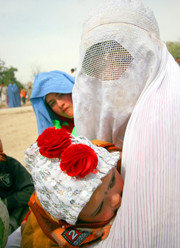Stagnant water in flood-affected parts of Afghanistan is the perfect breeding ground for malaria-causing mosquitoes, health specialists warn.

Pregnant women and children are particularly vulnerable to malaria - file photo
“We anticipate an increase in malaria cases this year,” Najibullah Safi, director of the National Malaria and Leishmaniasis Control Programme (NMLCP), told IRIN in Kabul.
“Malaria mosquitoes breed in wet conditions and because we have had ample rainfall this year there will be opportunities for an increase in malaria cases,” he said.
January-June floods affected over 21,000 households and caused extensive damage in over 15 of the country’s 34 provinces, according to reports by the UN Office for the Coordination of Humanitarian Affairs (OCHA).
At least 14 provinces (in the north, east and south) are highly vulnerable to malaria, especially in summer, officials say.
Afghanistan is considered to have the fourth largest malaria burden worldwide with an estimated annual incidence of 18 per 1,000 people in 2007, according to the UN World Health Organization (WHO).
“We cannot remedy all the stagnant water pools across the country in order to reduce malaria risks, but local people and municipalities can, and we’re calling on them to do so,” said Safi.
Progress threatened?
Over the past few years considerable progress has been made in curbing malaria - from 626,839 cases in 2002 to around 467,000 in 2008, according to the Ministry of Public Health (MoPH).
A fall in numbers has also been reported in the first three months of 2009 compared with the same period in 2008: 49,000 patients compared to over 53,000.
Health officials said the distribution of 1.2 million insecticide-treated bednets in 2008 and improved public awareness contributed to the reduction in the number of malaria patients.
“We are fully prepared to control a possible malaria outbreak,” said Safi, adding that over 600,000 insecticide-treated bednets would be distributed in malaria-prone areas this year.
Malaria diagnosis and treatment are freely available at hundreds of public health facilities, covering about 85 percent of the country, according to MoPH.
Donors have given over US$9 million to the NMLCP to enhance malaria preventative measures such as increased public awareness, Safi said.
Malaria affects hundreds of thousands of Afghans every year, but also acts as a major brake on economic development.
With support from international donors the MoPH is aiming to reduce malaria mortality by 90 percent and malaria morbidity by 60 percent by 2013, according to Afghanistan’s National Malaria Strategic Plan 2008-2013.



